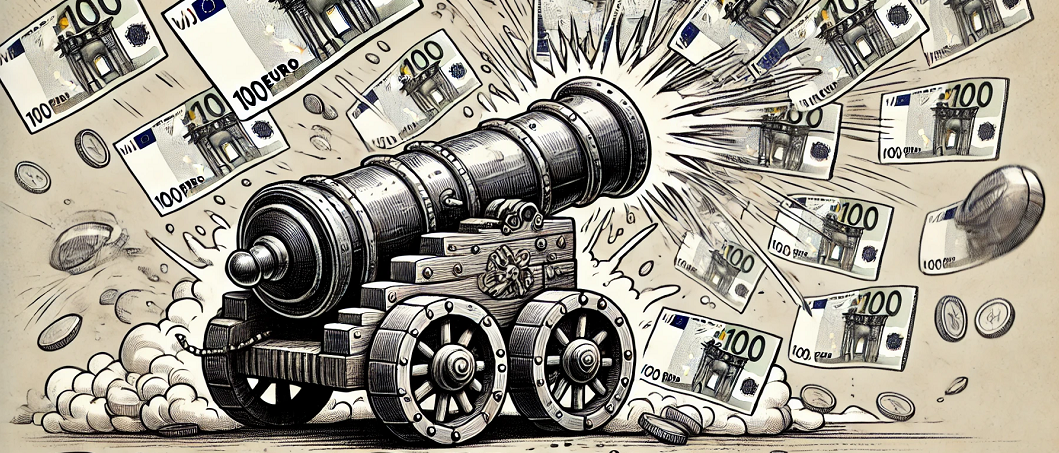Funding European defense has become an urgent issue, at the latest since Donald Trump's re-election as President of the USA. Germany, with a relatively low debt-to-GDP ratio of 63%, is now debating new borrowing to fund military rearmament and infrastructure renewal. At the European level, massive new bond issuances will likely be necessary to finance the continent’s rearmament. This wave of new debt could trigger a fresh wave of inflation in the medium term, as it is not backed by expected budget surpluses, and a significant share of the bonds will likely end up on the ECB’s balance sheet. The challenge for investors remains the best possible protection against inflation. In the past, tangible assets such as gold and equities have proven to be better inflation hedges in turbulent times.
Rising Supply of Government Bonds
Debt-financed defense spending will lead to a surge in bond supply. In 2024, gross bond issuance (maturities of at least one year) reached €1.9 trillion in the EU and €1.5 trillion in the Eurozone (Figure 1). Net new borrowing amounted to €700 billion in the EU and €462 billion in the Eurozone. If the bloc would increase defense spending from the current 2% of GDP to 5% in 2025, and refinancing needs remain unchanged, new bond issuance will need to rise to €2.5 trillion in the EU and €2 trillion in the Eurozone. This would correspond to an additional financing requirement of €600 billion in the EU and €500 billion in the Eurozone in 2025 alone. As a result, net new borrowing would rise to €1.3 trillion in the EU and €962 billion in the Eurozone—sums that will require willing investors.
A similar amount of debt was issued in 2020 during the COVID crisis. That year, gross issuance reached nearly €1.6 trillion, of which €1.1 trillion was net new debt. The ECB absorbed 95% of this new issuance by the end of 2020 and took in the remainder over the following years.1
Markets Have Already Priced in New Issuance
Markets are already anticipating a surge in government bond supply. Investors began selling German government bonds as early as late 2024, possibly because they suspected that the debt brake might be loosened after the ruling coalition collapsed. Now, with the official announcement of a €500 billion “special fund” for infrastructure investments and a relaxation of the debt brake for defense spending above 1% of GDP, yields on 10-year Bunds have continued to climb (Figure 2).
Uncertainty is growing and Germany's creditworthiness could be increasingly called into question. In an interest rate swap, one party secures a fixed rate for a specified period. The difference between this swap rate and the yield on German Bunds is the German swap spread. For years, the 10-year swap spread was positive. But recently, it plunged deep into negative territory (Figure 2). This suggests that borrowers, worried about fiscal and monetary policy uncertainty, are locking in fixed rates.
Nevertheless, by the end of the year, markets are pricing in at least 50 basis points of ECB rate cuts. This is reflected in the implied €STR, the rate derived from interest rate futures for unsecured overnight lending in the euro area (Figure 3). Since the ECB’s deposit facility rate sets the floor for interbank lending, a cut would push the €STR down accordingly. Futures suggest a 2% rate by December 2025, implying a 50 basis point reduction from the current 2.5%.
Inflation Will Follow
This rise in bond issuance is unlikely to be a temporary phenomenon. With geopolitical instability and Europe’s need to take greater responsibility for its defense, military spending will likely remain a larger share of national budgets. Cutting spending elsewhere will be politically difficult, as France has demonstrated. Instead, governments are working to circumvent constitutional debt limits by citing national security concerns.
The Fiscal Theory of the Price Level (FTPL) provides a framework for understanding the inflationary consequences of rising government debt.2 According to FTPL, if new debt is not backed by future budget surpluses, inflation must rise because investors will doubt long-term repayment. Inflation, in this view, results from fiscal imbalances: the real value of government liabilities (bonds + monetary base) exceeds expected future surpluses. Higher prices then reduce the real value of debt. Investors sell government bonds and shift into goods and assets, pushing up the price level until equilibrium is restored.
The mechanism for this adjustment is already underway. With the announcement of higher financing requirements, investors are selling government bonds in order to anticipate an expected fall in prices due to future supply. This causes bond prices to fall, while yields have recently risen again (Fig. 2). They then buy goods, real assets or alternative currencies.
A relaxation of the constitutional restrictions on debt financing, such as the German debt brake and the Maastricht criteria, is likely to further accelerate this dynamic. A weakening or even abolition of debt rules makes it easier for governments to take on new debt without having to ensure future budget surpluses to cover rising liabilities. Doubts about the ability to repay the debt may increase, which would prompt investors to sell more government bonds. This would further increase yields and make new debt more expensive - making it even more difficult to repay.
If confidence in the state's ability to repay its debts falls, confidence in the stability of the currency also suffers - without the central bank being able to do much about it. If the solvency of the state is called into question, the central bank has no choice but to monetize the debt in order to avoid a sovereign default. If governments in the eurozone continue with their costly social policies, there will be more demand for assets as well as consumer goods and services, which will increase both asset prices and consumer prices. If inflation accelerates, the public could lose confidence and dump fiat credit money in exchange for goods, services and inflation hedges.
It does not have to follow this exact pattern, but the FTPL makes clear that there would still be an inflation risk even without ECB intervention. If the ECB supports the financing of governments from the start, as it did during the pandemic, inflation can come earlier via the classic channel of monetizing government debt. With eurozone inflation currently at 2.4%, it remains to be seen whether the ECB will add more fuel to the inflation fire.
What Can Be Done?
A strong economy funds a strong military more effectively than debt can. High interest burdens constrain future fiscal flexibility, and runaway inflation fuels social unrest and political instability. A balanced budget strategy that ensures future debt repayment without perpetual borrowing would be the best way to secure Europe’s defense. If today's debt were backed by future surpluses, inflationary pressures would be far lower.
Alternatively, countries could finance military expansion via a digital currency, as suggested by Mayer (2025).3 However, such a shift may come too late for immediate implementation. A combination of inflation and euro depreciation seems the more likely scenario.
For investors, inflation hedging remains essential. As past episodes of sovereign debt monetization have shown, tangible assets provide protection. Over longer horizons, equities have delivered real returns, even during crises and wars. In acute financial turmoil, gold has historically outperformed.4
____________________________________________________________
1 See Duarte & Mayer (2021), Submission: Public Debt Financing by Central Banks, Comment, Flossbach von Storch Research Institute.
2 See Duarte & Mayer (2025), A constructive critique of “The Fiscal Theory of the Price Level”. Study, Flossbach von Storch Research Institute.
3 See Mayer (2025), Europe home alone, Comment, Flossbach von Storch Research Institute.
4 See Mayer (2022), Die Aktienanlage widersteht der Inflation, Study, Flossbach von Storch Research Institute.
LEGAL NOTICE
One of the purposes of this publication is to serve as advertising material.
The information contained and opinions expressed in this publication reflect the views of Flossbach von Storch at the time of publication and are subject to change without prior notice. Forward-looking statements reflect the judgement and future expectations of Flossbach von Storch. Actual performance and results may, however, differ materially from such expectations. All information has been compiled with care. However, no guarantee is given as to the accuracy and completeness of information and no liability is accepted. The value of any investment can fall as well as rise and you may not get back the amount you invested
This publication does not constitute an offer to sell, purchase or subscribe to securities or other assets. The information and estimates contained herein do not constitute investment, legal and/or tax advice or any other form of recommendation. In particular, this information is not a replacement for suitable investor and product-related advice and, if required, advice from legal and/or tax advisers.
This publication is subject to copyright, trademark and intellectual property rights. The reproduction, distribution, making available for retrieval, or making available online (transfer to other websites) of the publication in whole or in part, in modified or unmodified form is only permitted with the prior written consent of Flossbach von Storch.
Past performance is not a reliable indicator of future performance.
© 2025 Flossbach von Storch. Alle Rechte vorbehalten.




